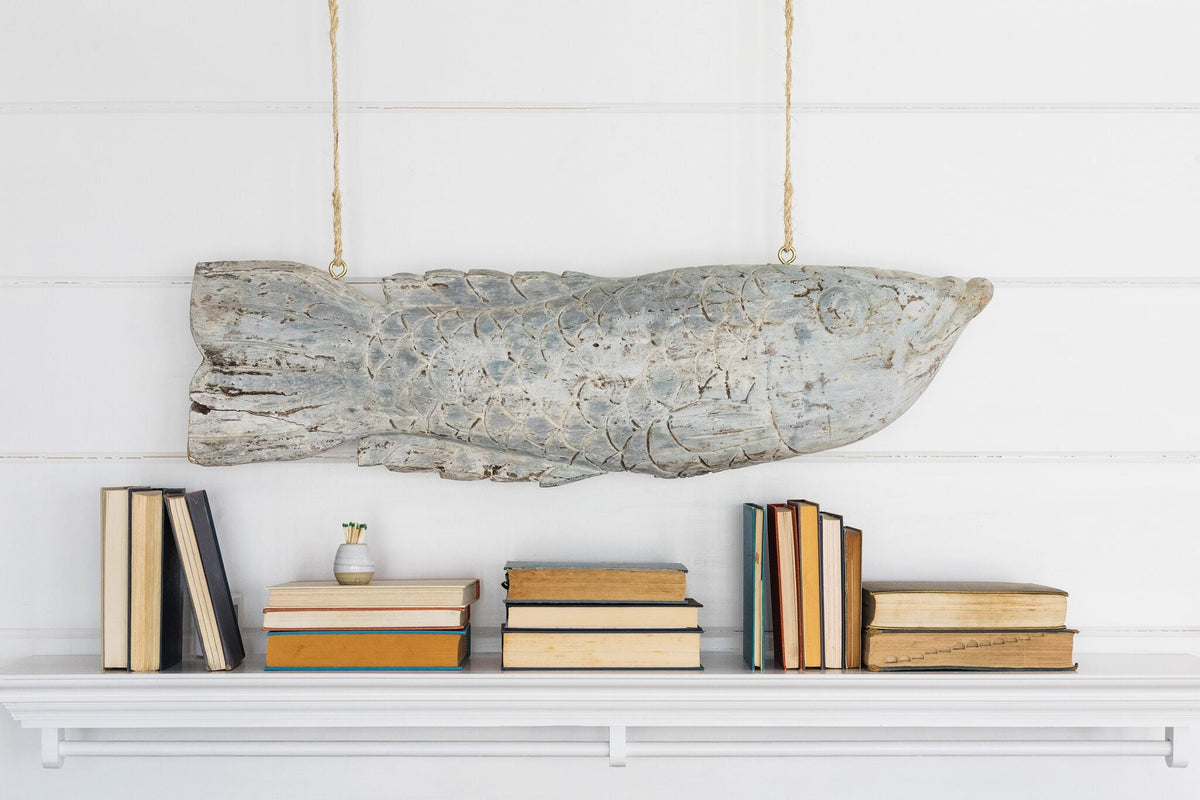
Life by the Sea: Let Your Home Tell the Story with Coastal Details
|
|
Time to read 4 min
Coastal living is all about the details. It's about seeking out those special finds, old or new that tell the story of living by the water. Sometimes the details take the lead and at other times they are part of the background. We're sharing some ideas...
Ahh, nothing says Coastal Living quite like the hand-carved wooden cod hanging over our mantel at Laughing Gull Hill. A few dings and cracks makes it even more authentically coastal! Ramble Market in Waltham MA is a great place for such treasures. The little Farmhouse Pottery match holder and striker steals the show on the mantel.
Preserving History: How to Make Non-Working Fireplaces a Design Feature in a Historic Coastal Home
Laughing Gull Hill (LGH) the late 1700s home of Sea Captain James Childs, is now home to my family and the Design No. Five Studio. Nestled near Cotuit Harbor, Laughing Gull Hill was once heated by at least six fireplaces. While only one remains functional today, three others stand as decorative focal points, rich with history. Rather than letting these non-working fireplaces fade into the background, they can be reimagined as design statements that honor the home’s maritime heritage.

In the kitchen, where meals were once prepared over an open flame, the fireplace mantel is now guarded by the Rorqual du Nord, a nod to the home’s whaling-era history. Even when non-functional, these fireplaces remain key architectural storytelling elements—proving that history and design can seamlessly blend in modern coastal interiors. For those restoring or decorating a historic coastal home, embracing these non-working fireplaces as touchstones of history, connecting the present to the era when Captain Childs set sail from Cotuit Harbor. They remind us that a home’s character is not just in what functions, but in what tells its story.

These coastal details remind us that a home’s character is not just in what functions, but in what tells its story.

Historic New England Charm meets Modern Kitchen Design
This blend of historic New England charm and modern kitchen design ensures that the space remains both authentic to its 18th-century roots and fully equipped for today’s coastal lifestyle. The result is a Cape Cod kitchen where history meets luxury—perfect for both everyday cooking and entertaining, plus the Design N° Five crew gets to have coffee here every morning on their way to the studio. The DN5 Studio is set up in an 1800s structure that was sailed across Nantucket Sound and added to Laughing Gull Hill – we would have loved to see this endeavor!


How to Achieve the Perfect Coastal Cottage Style
Coastal doesn't have to be fancy, just authentically creative. A Cotuit skiff sailboat mast and gaff make a great newel post and rail. Add a few brass cleats and manilla roping and you’ve got a stairway that feels straight out of a classic seaside retreat.
Having a husband who is a Cotuit sailor makes it easier to repurpose skiff rigging, since we already have a stash of broken and exhausted boat parts in the barn—no need to search far and wide for these coastal details. This staircase pays homage to Laughing Gull Hill’s deep-rooted maritime history and Cotuit’s legacy of sailing skiffs. Coastal living is all about the details—thoughtful, weathered, and rich with character.


Hidden Design Potential: Hallways, Nooks, and Crannies You Shouldn’t Ignore
Hallways need a little love too...oversized black and white photography of ratlines and spinnakers instantly captures the essence of coastal summer living! A basket of wooden buoys adds texture and warmth, perfectly complementing the rust-red cotton runner by Nordic Knots. The bootjack-legged pine bench brings in a relaxed, beach-house feel, while the striped brass sconce from Schoolhouse Electric ties everything together with a touch of nautical charm. Small coastal details make a big impact in achieving a coastal-inspired home!
Laundry room nooks and crannies matter—especially in a summer beach house! Every home needs a catch-all for beach essentials, and a wire storage unit is the perfect spot. Topping it off are vintage coastal collectibles—a classic fishing creel and a seagull whirligig, adding nautical charm to the space. Antique shopping is a must for unique coastal finds! And, of course, no beach house is complete without plush Serena & Lily beach towels—both stylish and practical. Coastal home organization has never looked this good!


“The details are not the details. They make the design.”
The History of Door Knockers
In centuries past, door knockers weren’t just decorative—they symbolized a resident’s social status or profession. A fish-shaped door knocker or one featuring a sea creature signified that the homeowner was part of the sea merchant community or worked in a maritime trade. Sea Captain James Childs would be so proud that the house he built still stands after 200+ years and the custom-made door knocker continues to greet our guests.

Let’s explore the history behind more of our coastal details ...
1. In older coastal cottages and fishing villages, space was often limited, and kitchens were designed for function rather than formality. Open shelving was common as it mimicked ship storage.



2. Monkey’s Fists were first created by Sailors as a way to weight their heaving lines. This method allowed for more accuracy when throwing lines from ship to dock or between vessels. Adding a something of weight in the monkey’s fist could also be used as a weapon when Pirates came aboard ship.
3. These hand-crafted Starfish drawer pulls were found on Etsy. We needed a pop of color on our bar in the cocktail room. Some seafarers believed that starfish were a good omen, representing protection and safe travels. Just as the North Star kept sailors from losing their way, the starfish—often depicted in maritime carvings, tattoos, or ship décor—was a symbol of stability and resilience in the ever-changing tides.
Shop Design No. Five for easy Coastal Design Details
Related readings



